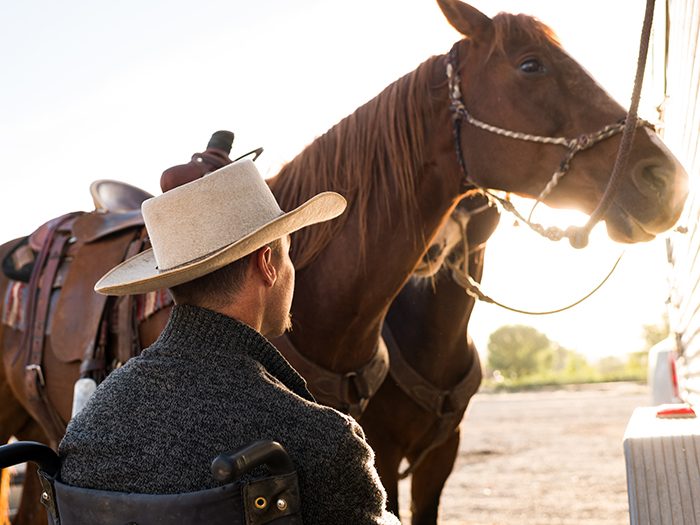Nurse Case Manager Chronicles
Thrown from a Horse: How Technology Gave One Worker His Life Back

Thrown from a horse. Injured with a broken back. Left as a paraplegic.
He was a young man in his mid-twenties, working on a ranch as a foreman. He used four-wheelers daily, rode horses and drove a pick-up truck. At home, he had a wife and two young kids. He hunted game to provide food for his family.
This foreman needed to work.
“He was determined to get back to work despite the obstacles set before him,” said Kevin Glennon, vice president of clinical programs for One Call. Glennon, who has been with One Call for 22 years, was a nurse case manager at the time. He was assigned to the foreman’s case and knew exactly what he had to do.
“I had to tap into the available technology to get him back to work as a functioning member of society.”
Finding the Right Devices
“Every year there are more and more advancements with technology,” said Glennon.
For this worker, Glennon needed to find devices that could support him both on the ranch and in his home. Glennon approached the carrier and adjuster with his plans to include innovative technologies in the recovery plan. Lucky for him, they were in full support.
As an avid hunter, the foreman needed a way to get into a deer stand. Glennon researched “hydraulic deer stand” and found a lot of different products. To get the foreman back on his horse, Glennon researched “specialty saddles for horses for paraplegics.”
“Thank goodness for the internet,” quipped Glennon. Before, he had to search catalogs for this kind of workers’ comp tech.
Now, the internet acts as a jumping point, providing an answer to the most important question: Is there a technology out there for this?
Cost-Effective Solutions
Sometimes the more “high-tech” devices are actually the most cost-effective in a workers’ comp case. A standing wheelchair, for example, can replace the need for multiple devices.
“I like to explain to the carrier that instead of buying multiple pieces of equipment, like a wheelchair and standing table, sometimes we can buy one that does it all,” said Glennon. “That’s cost-effective for everyone, including the injured worker who won’t need to make room for two devices.”
“Innovative approaches foster independence in patients and increase their self-esteem and self-worth. Technology today can make all the difference in a case. It provides case managers with so many more options than they had just a few decades ago.” — Kevin Glennon, vice president of clinical programs, One Call
The foreman qualified for a standing wheelchair and a ramp was placed inside the barn where he worked, which was used to raise him up to a horse’s height. A trapeze, which the foreman used to hoist himself onto his horse, was also installed.
Additionally, Glennon, as the case manager, found a saddle that comfortably supported the foreman atop his horse without straining the animal.
“Someone else has to strap him in [to the saddle], but once he’s on, he’s good to go,” said Glennon.
And as for this worker’s personal life, Glennon acquired a hydraulic deer stand. This stand enabled the worker to wheel himself into the cabin and use a button to raise the stand to a hunting height.
“Innovative approaches foster independence in patients and increase their self-esteem and self-worth,” said Glennon. “Technology today can make all the difference in a case. It provides case managers with so many more options than they had just a few decades ago.”
Increasing independence decreases the need for attendant care, which is typically $30 to $35 an hour, Glennon explained. This, in turn, keeps the injured worker less dependent on the health care system.
“That’s the biggest thing technology is doing — fostering independence.”
The Endless Possibilities of Technology
New devices can impact many types of claims. One type of technology making waves in the workers’ comp industry is wearables.
“When we talk about wearable technology, most people think about watches or the new iPhone. People don’t often think about manual wheelchairs in terms of a wearable, but they can bring a person into an upright position,” said Glennon.
While standing wheelchairs enable a paraplegic to move around, reach items on high shelves or get back to work, something as simple as a GPS monitor inserted into a shoe can foster that same independence for someone with a minor brain injury.
“It’s just like a Dr. Scholl’s insert, and it will track people with mild head injuries who might get lost,” said Glennon.
Wearables also promote safety by preventing injury from happening in the first place. There are helmets with sensors that alert users to physical hazards in their work environment. Exoskeletons are built to prevent workers from overextending at work. Chips have been embedded in workers’ clothing to detect safe noise levels and temperature.
“As technology continues to advance, it’s important to always look for ways to keep workers safe, independent and returning to work.”
And as for the case of the foreman: “He maintained his foreman status. That claim had no attorney involvement, and he went on to have three more kids.” &











